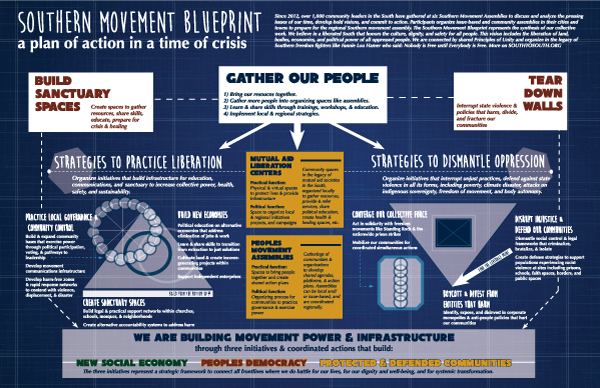Southern Movement Blueprint: A Plan of Action Created by the People for the People
Oct 23, 2018
Many of the articles in this edition of Tenant Talk point to the failure of the government to end segregation and discrimination, and to protect people that are vulnerable. Many communities across the country are organizing to find their own solutions to these problems.
Since 2012, community leaders from across the South have gathered at seven Southern Movement Assemblies to discuss the major issues affecting their neighborhoods, develop bold visions for the future, and commit to action. The result of these efforts is the Southern Movement Blueprint – a framework for creating a “new social economy,” a “people’s democracy” and a “defense of marginalized communities.”
The first part of the vision, creating a new social economy, means confronting harmful economies and constructing new institutions and practices like cooperatives. A people’s democracy means building coordinated local community-rule for “movement power.” The last part of the vision, protecting and defending communities, means working to eliminate “state violence” in all its forms.

The Southern Movement Blueprint identifies failed economies, false democracy and state violence as targets to hold accountable. Failed economies refer to markets that exploit communities, gentrification that displaces people and the elimination of jobs due to global systems of finance and technology. False democracy is voter disenfranchisement and restrictions that prevent people from participating in their civic duties. State violence refers to physical violence, economies of scarcity and environmental racism that are rising in communities every day.
There are many initiatives the blueprint suggests as means to eliminate the threats to communities. Strategies to practice liberation and to interrupt and dismantle oppression are proposed to create change in communities. Strategies of liberation include practicing local governance and community control and building new economies by supporting and establishing local businesses, learning and sharing hard skills, and cultivating community-controlled funds. Strategies to interrupt and dismantle oppression are mobilization and convergence, disruption and defense, and boycotts. Examples of strategies to dismantle oppression are standing in solidarity with Standing Rock and investigating and targeting Southern companies that have profited from ecological disasters.
The Southern Movement Blueprint also incorporates community infrastructure practices in order to create the vision of the Southern Movement Assembly. Mutual Aid Liberation Centers are community spaces organized locally to gather resources and support rapid response to crisis. They are spaces that provide sanctuary and an entry point for people to join the movement. Community and Frontline Assemblies are gatherings to practice governance from the bottom up. One example of an assembly is the Labor and Climate Assembly which organizes workers and community members directly affected by climate disasters and exploitative industries to build long-term strategies for just transitions.
The Southern Movement Blueprint offers a plan of action that builds slowly towards a Southern infrastructure connecting local communities through work, principles and values. There is room for everyone in the plan. If you are looking for ways to take local action in your community, and like the concept of the blueprint, you can learn more by going to www.southtosouth.org.